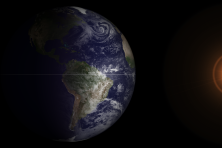Rare Celestial Crossing May 9
- Share
- Tweet
- Pin
- Share
NASA is inviting viewers around the world to see a relatively rare celestial event, with coverage of the Monday, May 9, transit of the sun by the planet Mercury. Mercury passes between Earth and the sun only about 13 times a century, its last trek taking place in 2006. Due to its diminutive size, viewing this event safely requires a telescope or high-powered binoculars fitted with solar filters made of specially coated glass or Mylar. NASA is offering several avenues for the public to view the event without specialized and costly equipment, including images on NASA.gov, a one-hour NASA Television special, and social media coverage. Mercury will appear as a small black dot as it crosses the edge of the sun and into view at 6:12 am. The planet will make a leisurely journey across the face of the sun, reaching mid-point at approximately 9:47 am, and exiting the golden disk at 1:42 pm.



